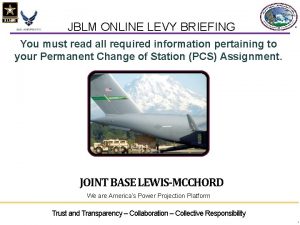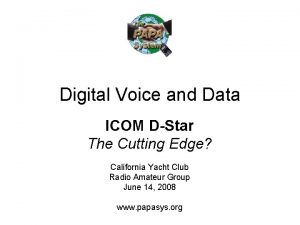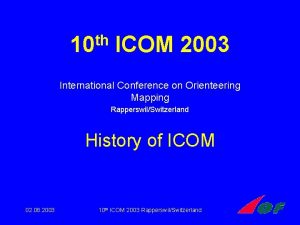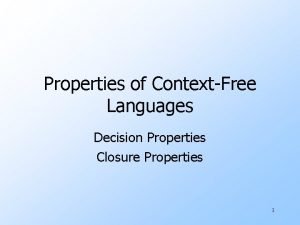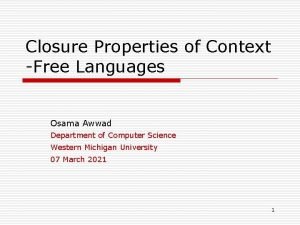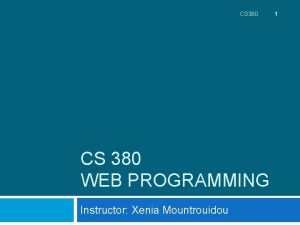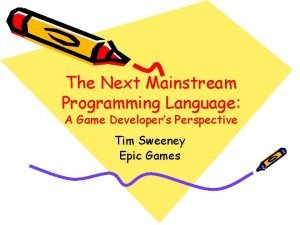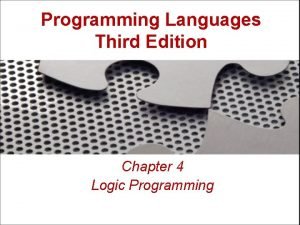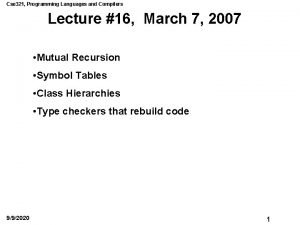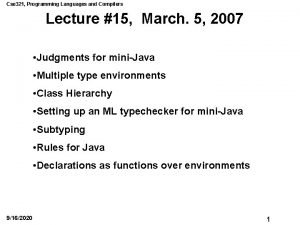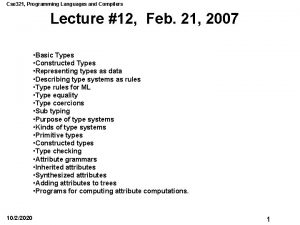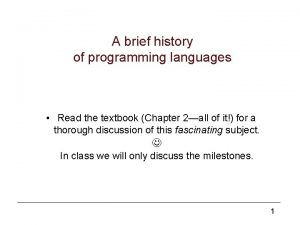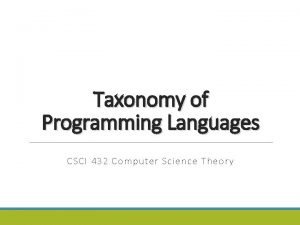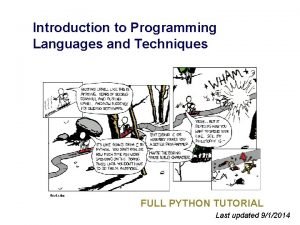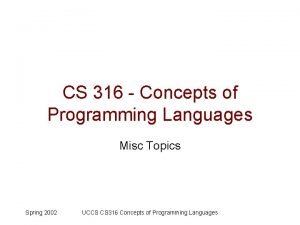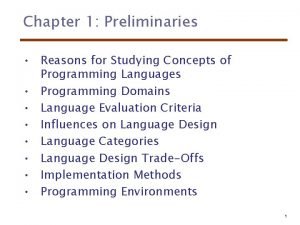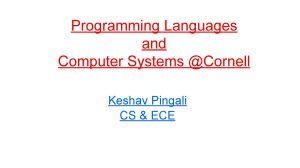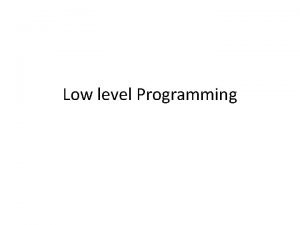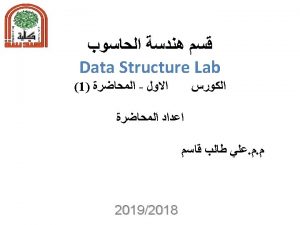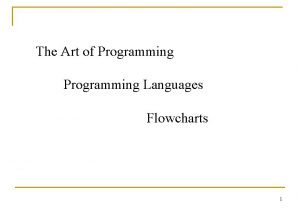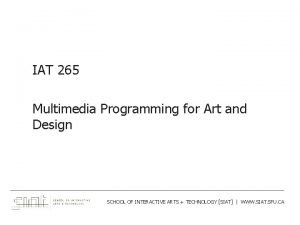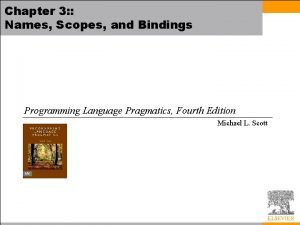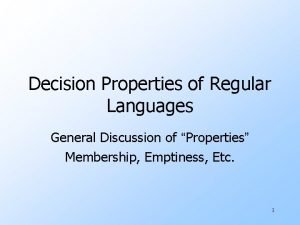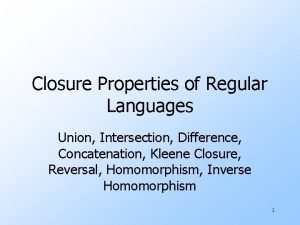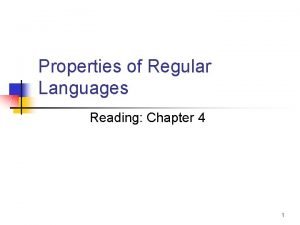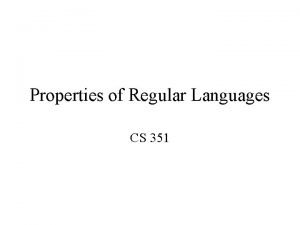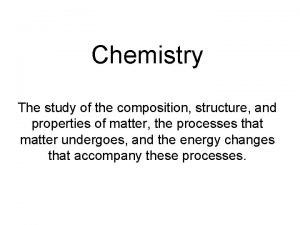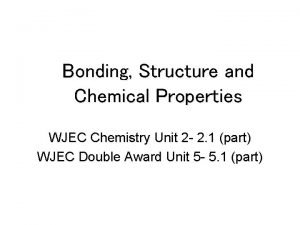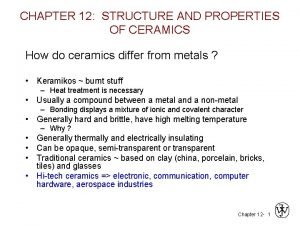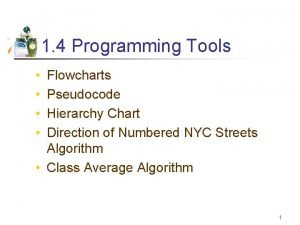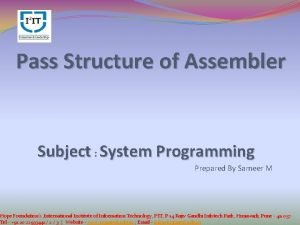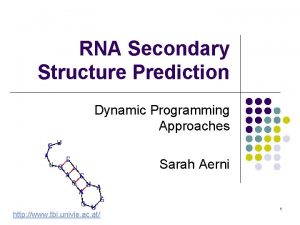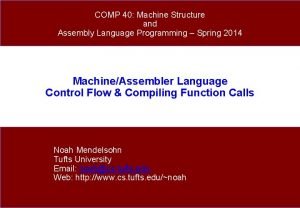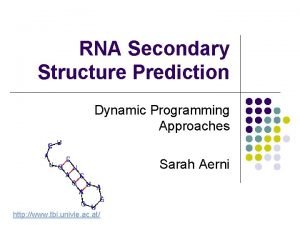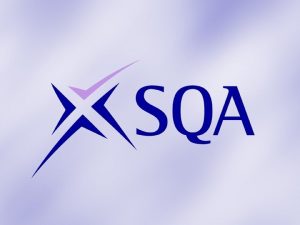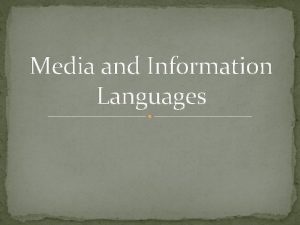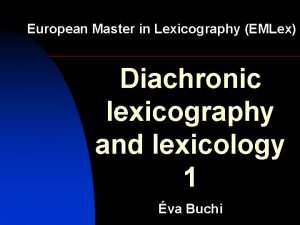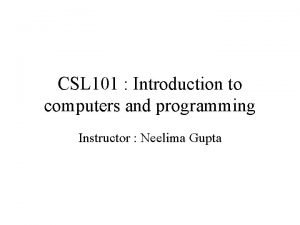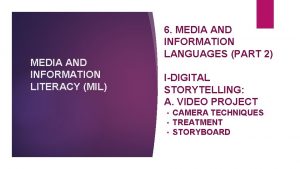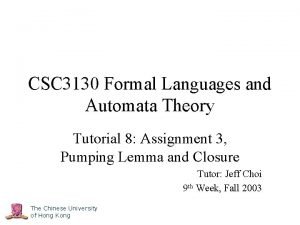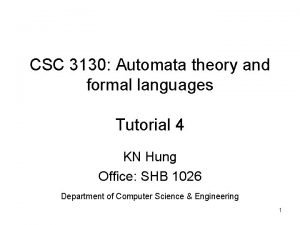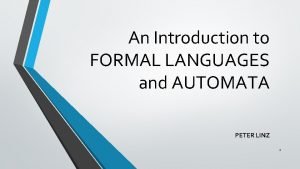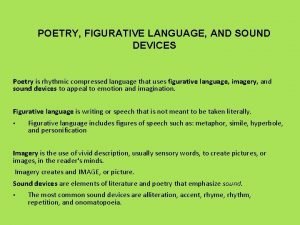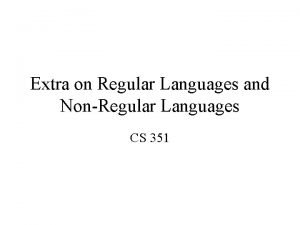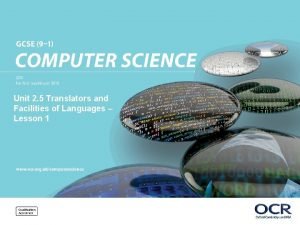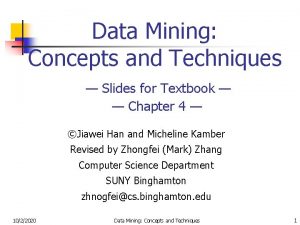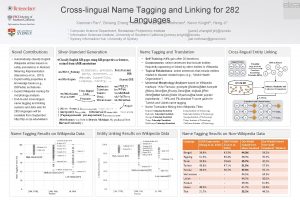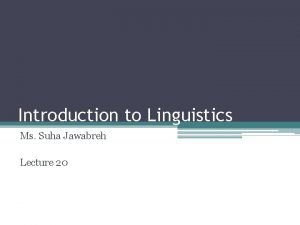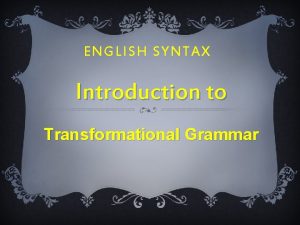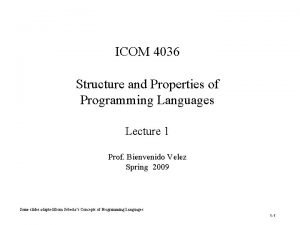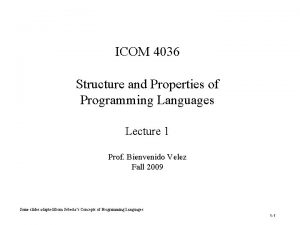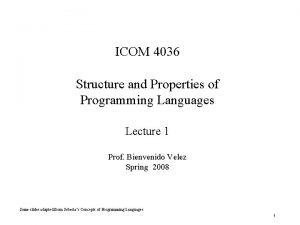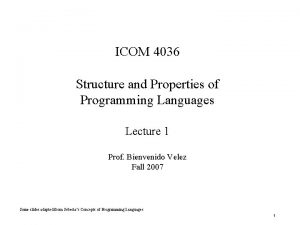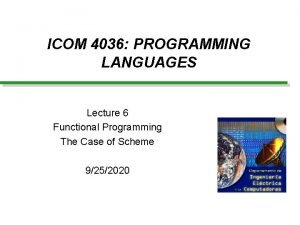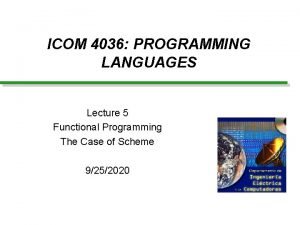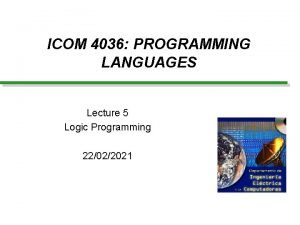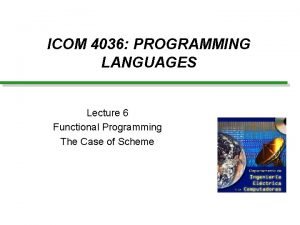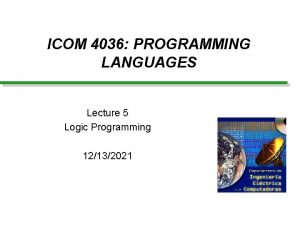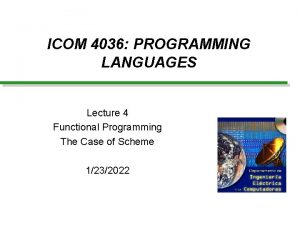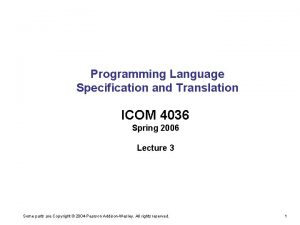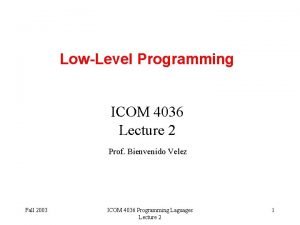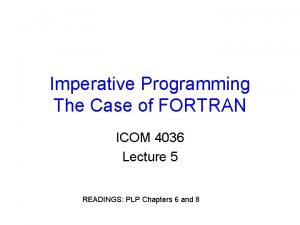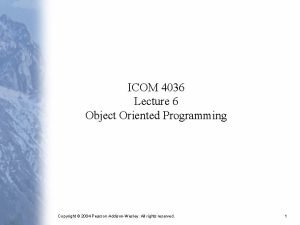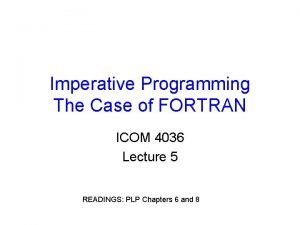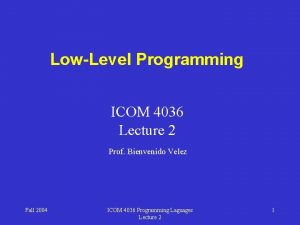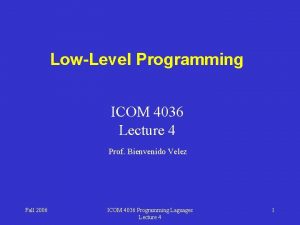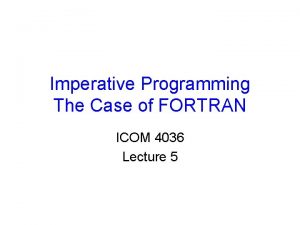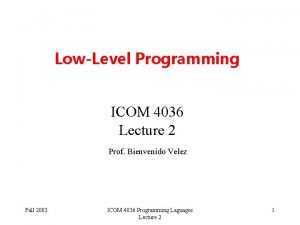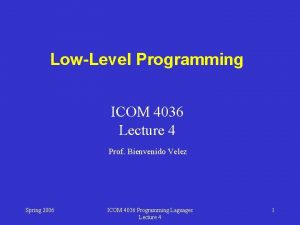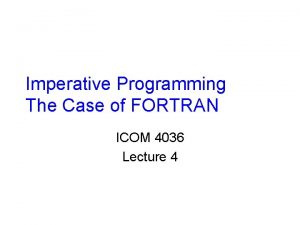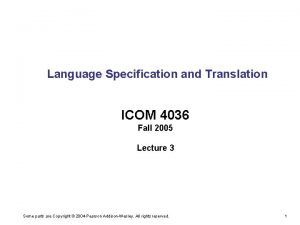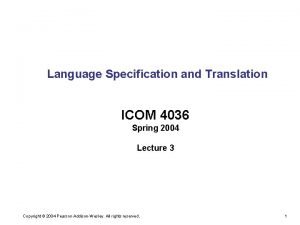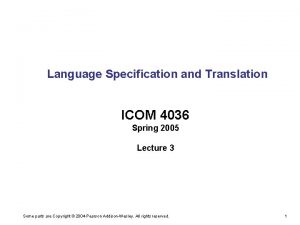ICOM 4036 Structure and Properties of Programming Languages

















































































![Plankalkül • Notation: A[7] = 5 * B[6] | 5 * B => A Plankalkül • Notation: A[7] = 5 * B[6] | 5 * B => A](https://slidetodoc.com/presentation_image/c557b134741f25aaf1e3815027ef3acb/image-82.jpg)









- Slides: 91

ICOM 4036 Structure and Properties of Programming Languages Lecture 1 Copyright © 2004 Pearson Addison-Wesley. All rights reserved. 1

Outline • • Motivation Programming Domains Language Evaluation Criteria Influences on Language Design Language Categories Language Design Trade-Offs Implementation Methods Milestones on PL Design Copyright © 2004 Pearson Addison-Wesley. All rights reserved. 2

What is a Programming Language? • A Programming Language … – – – – . . . provides an encoding for algorithms …should express all possible algorithms. . . must be decodable by an algorithm. . . should support complex software …should be easy to read and understand. . . should support efficient algorithms …should support complex software …should support rapid software development Copyright © 2004 Pearson Addison-Wesley. All rights reserved. 3

Motivation: Why Study Programming Languages? • Increased ability to express ideas • Improved background for choosing appropriate languages • Greater ability to learn new languages • Understand significance of implementation • Ability to design new languages • Overall advancement of computing Copyright © 2004 Pearson Addison-Wesley. All rights reserved. 4

Programming Domains • Scientific applications – Large number of floating point computations • Business applications – Produce reports, use decimal numbers and characters • Artificial intelligence – Symbols rather than numbers manipulated. Code = Data. • Systems programming – Need efficiency because of continuous use. Low-level control. • Scripting languages – Put a list of commands in a file to be executed. Glue apps. • Special-purpose languages – Simplest/fastest solution for a particular task. Copyright © 2004 Pearson Addison-Wesley. All rights reserved. 5

Language Evaluation Criteria • • • Readability Writability Reliability Cost Others The key to good language design consists of crafting the best possible compromise among these criteria Copyright © 2004 Pearson Addison-Wesley. All rights reserved. 6

Language Evaluation Criteria Readability • Overall simplicity – Too many features is bad – Multiplicity of features is bad • Orthogonality – Makes the language easy to learn and read – Meaning is context independent – A relatively small set of primitive constructs can be combined in a relatively small number of ways – Every possible combination is legal – Lack of orthogonality leads to exceptions to rules Copyright © 2004 Pearson Addison-Wesley. All rights reserved. 7

Language Evaluation Criteria Writability • • Simplicity and orthogonality Support for abstraction Support for alternative paradigms Expressiveness Copyright © 2004 Pearson Addison-Wesley. All rights reserved. 8

Language Evaluation Criteria Reliability Some PL features that impact reliability: • Type checking • Exception handling • Aliasing Copyright © 2004 Pearson Addison-Wesley. All rights reserved. 9

Language Evaluation Criteria Cost What is the cost involved in: • • Training programmers to use language Writing programs Compiling programs Executing programs Using the language implementation system Risk involved in using unreliable language Maintaining programs Copyright © 2004 Pearson Addison-Wesley. All rights reserved. 10

Language Evaluation Criteria Other • • • Portability Generality Well-definedness Elegance Availability … Copyright © 2004 Pearson Addison-Wesley. All rights reserved. 11

Some Language Design Trade-Offs • Reliability vs. cost of execution • Readability vs. writability • Flexibility vs. safety Copyright © 2004 Pearson Addison-Wesley. All rights reserved. 12

Influences on Language Design • Computer architecture: Von Neumann • We use imperative languages, at least in part, because we use von Neumann machines – Data and programs stored in same memory – Memory is separate from CPU – Instructions and data are piped from memory to CPU • Basis for imperative languages – Variables model memory cells – Assignment statements model piping – Iteration is efficient Copyright © 2004 Pearson Addison-Wesley. All rights reserved. 13

Von Neumann Architecture Copyright © 2004 Pearson Addison-Wesley. All rights reserved. 14

Influences on Language Design Through the Years • Programming methodologies thru time: – 1950 s and early 1960 s: • Simple applications; worry about machine efficiency – Late 1960 s: • People efficiency became important; • readability, better control structures • Structured programming • Top-down design and step-wise refinement – Late 1970 s: Process-oriented to data-oriented • data abstraction – Middle 1980 s: Re-use, Moudularity • Object-oriented programming – Late 1990 s: Portability, reliability, security • Java Copyright © 2004 Pearson Addison-Wesley. All rights reserved. 15

Programming Paradigms • Imperative – Central features are variables, assignment statements, and iteration – Examples: FORTRAN, C, Pascal • Functional – Main means of making computations is by applying functions to given parameters – Examples: LISP, Scheme • Logic – Rule-based – Rules are specified in no special order – Examples: Prolog • Object-oriented – – Encapsulate data objects with processing Inheritance and dynamic type binding Grew out of imperative languages Examples: C++, Java Languages typically support more than one paradigm although not equally well Copyright © 2004 Pearson Addison-Wesley. All rights reserved. 16

Layered View of Computer Each Layer Implements a Virtual Machine with its own Programming Language Copyright © 2004 Pearson Addison-Wesley. All rights reserved. 17

Virtual Machines (VM’s) Type of Virtual Machine Examples Instruction Elements Data Elements Comments Application Programs Spreadsheet, Word Processor Drag & Drop, GUI ops, macros cells, paragraphs, sections Visual, Graphical, Interactive Application Specific Abstractions Easy for Humans Hides HLL Level High-Level Language C, C++, Java, FORTRAN, Pascal if-then-else, procedures, loops arrays, structures Modular, Structured, Model Human Language/Thought General Purpose Abstractions Hides Lower Levels Assembly-Level SPIM, MASM directives, pseudoinstructions, macros registers, labelled memory cells Symbolic Instructions/Data Hides some machine details like alignment, address calculations Exposes Machine ISA Machine-Level (ISA) MIPS, Intel 80 x 86 load, store, add, branch bits, binary addresses Numeric, Binary Difficult for Humans Copyright © 2004 Pearson Addison-Wesley. All rights reserved. 18

Computing in Perspective People Computer Human Interaction, User Interfaces Application Programs CS 1/CS 2, Programming, Data Structures ICOM High-Level Language 4036 Programming Languages, Compilers Assembly Language Computer Architecture Machine Language (ISA) People computers Each layer implements an INTERPRETER for some programming language Copyright © 2004 Pearson Addison-Wesley. All rights reserved. 19

Implementation Methods Compilation • Translate high-level program to machine code • Slow translation • Fast execution Copyright © 2004 Pearson Addison-Wesley. All rights reserved. 20

Implementation Methods Interpretation • No translation • Slow execution • Common in Scripting Languages Copyright © 2004 Pearson Addison-Wesley. All rights reserved. 21

Implementation Methods Hybrid Approaches • Small translation cost • Medium execution speed • Portability Examples of Intermediate Languages: • Java Bytecodes • . NET MSIL Java VM Copyright © 2004 Pearson Addison-Wesley. All rights reserved. 22

Software Development Environments (SDE’s) • The collection of tools used in software development • GNU/FSF Tools – Linux, Servers, and other free software • Borland JBuilder – An integrated development environment for Java • Microsoft Visual Studio. NET – A large, complex visual environment – Used to program in C#, Visual BASIC. NET, Jscript, J#, or C++ • IBM Web. Sphere Studio – Specialized with many wizards to support webapp development Copyright © 2004 Pearson Addison-Wesley. All rights reserved. 23

Genealogy of High-Level Languages Copyright © 2004 Pearson Addison-Wesley. All rights reserved. 24

Machine Code – Computer’s Native Language Address I Bit Opcode (binary) X (base 10) 0 0 00 110 0 2 0 00 111 12 4 0 00 1000 • Architecture specific 6 0 00 110 0 • Interpreted by the processor 10 • Binary encoded instruction sequence • Hard to read and debug int a = 12; int b = 4; int result = 0; main () { if (a >= b) { while (a > 0) { a = a - b; result ++; } } } 8 12 Machine 0 Code Instruction: 00 111 0001110000001100 0 00 2 100 1 C 0 C 16 0 00 110 4 1004 0 14 0 00 1008 16 0 00 101 1004 18 0 00 000 unused 20 0 00 111 1 22 1 00 111 1000 24 0 00 010 46 26 0 00 101 1000 28 0 00 010 46 30 0 00 101 1004 32 0 00 000 unused 34 0 00 111 1 36 0 00 1000 38 0 00 101 1008 40 0 00 111 1 42 0 00 1008 44 0 00 011 26 Copyright © 2004 Pearson Addison-Wesley. All rights reserved. 25

Assembly Language Improvements • Symbolic names for each machine instruction • Symbolic addresses • Macros 0: main: But • Requires translation step • Still architecture specific int a = 12; int b = 4; int result = 0; main () { if (a >= b) { while (a > 0) { a = a - b; result ++; } } } loop: andi addi storei andi storei loadi comp addi add brni loadi comp addi add storei loadi addi storei jumpi 0 12 1000 0 4 1004 0 1008 1004 1 1000 exit 1000 endloop 1004 1 1000 1008 1 1008 loop # AC = 0 # a = 12 (a stored @ 1000) # AC = 0 # # # b = 4 (b stored @ 1004) AC = 0 result = 0 (result @ 1008) compute a – b in AC using 2’s complement add # exit if AC negative # compute a – b in AC # using 2’s complement add # Uses indirect bit I = 1 # result = result + 1 endloop: exit: Copyright © 2004 Pearson Addison-Wesley. All rights reserved. 26

Genealogy of High-Level Languages Copyright © 2004 Pearson Addison-Wesley. All rights reserved. 27

IBM 704 and the FORmula TRANslation Language • State of computing technology at the time – – – Computers were resource limited and unreliable Applications were scientific No programming methodology or tools Machine efficiency was most important Programs written in key-punched cards • As a consequence – Little need for dynamic storage – Need good array handling and counting loops – No string handling, decimal arithmetic, or powerful input/output (commercial stuff) – Inflexible lexical/syntactic structure Copyright © 2004 Pearson Addison-Wesley. All rights reserved. 28

subroutine checksum(buffer, length, sum 32) FORTRAN Example Some Improvements: • Architecture independence • Static Checking • Algebraic syntax • Functions/Procedures • Arrays • Better support for Structured Programming • Device Independent I/O • Formatted I/O C Calculate a 32 -bit 1's complement checksum of the input buffer, adding it to the value of sum 32. This algorithm assumes that the buffer length is a multiple of 4 bytes. C C C a double precision value (which has at least 48 bits of precision) is used to accumulate the checksum because standard Fortran does not support an unsigned integer datatype. C C C buffer length sum 32 C C C 10 - integer buffer to be summed - number of bytes in the buffer (must be multiple of 4) - double precision checksum value (The calculated checksum is added to the input value of sum 32 to produce the output value of sum 32) integer buffer(*), length, i, hibits double precision sum 32, word 32 parameter (word 32=4. 294967296 D+09) (word 32 is equal to 2**32) LENGTH must be less than 2**15, otherwise precision may be lost in the sum if (length. gt. 32768)then print *, 'Error: size of block to sum is too large' return end if do i=1, length/4 if (buffer(i). ge. 0)then sum 32=sum 32+buffer(i) else sign bit is set, so add the equivalent unsigned value sum 32=sum 32+(word 32+buffer(i)) end if end do fold any overflow bits beyond 32 back into the word hibits=sum 32/word 32 if (hibits. gt. 0)then sum 32=sum 32 -(hibits*word 32)+hibits go to 10 end if end Copyright © 2004 Pearson Addison-Wesley. All rights reserved. 29

Evolution of FORTRAN • FORTRAN 0 - 1954 – Never implemented • FORTRAN I - 1957 – Designed for the new IBM 704, which had index registers and floating point hardware • FORTRAN II – 1958 • FORTRAN IV - 1960 -62 • FORTRAN 77 – 1978 • FORTRAN 90 - 1990 Over fifty years and still one of the most widely used languages Copyright © 2004 Pearson Addison-Wesley. All rights reserved. 30

FORTRAN I (1957) • First implemented version of FORTRAN • Compiler released in April 1957 (18 worker-years of effort) • Language Highlights – – – – – Names could have up to six characters Post-test counting loop (DO) Formatted I/O User-defined subprograms Three-way selection statement (arithmetic IF) No data typing statements No separate compilation Code was very fast Quickly became widely used Copyright © 2004 Pearson Addison-Wesley. All rights reserved. 31

FORTRAN Evolution • FORTRAN I (1957) • FORTRAN II (1958) – Independent or separate compilation – Fixed compiler bugs • FORTRAN IV (1960 -62) – – Explicit type declarations Logical selection statement Subprogram names could be parameters ANSI standard in 1966 • FORTRAN 77 (1978) – Character string handling – Logical loop control statement – IF-THEN-ELSE statement – Still no recursion • FORTRAN 90 (1990) – – – Modules Dynamic arrays Pointers Recursion CASE statement Parameter type checking Copyright © 2004 Pearson Addison-Wesley. All rights reserved. 32

Genealogy of High-Level Languages Copyright © 2004 Pearson Addison-Wesley. All rights reserved. 33

LISP - 1959 • LISt Processing language (Designed at MIT by Mc. Carthy) • AI research needed a language that: – Process data in lists (rather than arrays) – Symbolic computation (rather than numeric) • Only two data types: atoms and lists • Syntax is based on lambda calculus • Pioneered functional programming – No need for variables or assignment – Control via recursion and conditional expressions • Same syntax for data and code Copyright © 2004 Pearson Addison-Wesley. All rights reserved. 34

Representation of Two LISP Lists (A B C D) (A (B C) D (E (F G))) Copyright © 2004 Pearson Addison-Wesley. All rights reserved. 35

Scheme Example ; ; ; From: Structure and Interpretation of Computer Programs ; ; ; (Harold Abelson and Gerald Jay Sussman with Julie Sussman) (define (product? x) (if (not (atom? x)) (eq? (car x) '*) nil)) ; ; ; Added by Bjoern Hoefling (for usage with MIT-Scheme) (define (multiplier p) (cadr p)) (define (atom? x) (or (number? x) (string? x) (symbol? x) (null? x) (eq? x #t))) (define (multiplicand p) (caddr p)) ; ; ; Section 2. 2. 4 -- Symbolic differentiation (define (deriv exp var) (cond ((constant? exp) 0) ((variable? exp) (if (same-variable? exp var) 1 0)) ((sum? exp) (make-sum (deriv (addend exp) var) (deriv (augend exp) var))) ((product? exp) (make-sum (make-product (multiplier exp) (deriv (multiplicand exp) var)) (make-product (deriv (multiplier exp) var) (multiplicand exp)))))) (define (constant? x) (number? x)) (define (variable? x) (symbol? x)) (define (same-variable? v 1 v 2) (and (variable? v 1) (variable? v 2) (eq? v 1 v 2))) ; ; ; examples from the textbook (deriv '(+ x 3) 'x) ; Value 1: (+ 1 0) (deriv '(* x y) 'y) ; Value 2: (+ (* x 1) (* 0 y)) (deriv '(* (* x y) (+ x 3)) 'x) ; Value 3: (+ (* (* x y) (+ 1 0)) (* (+ (* x 0) (* 1 y)) (+ x 3))) ; ; ; Better versions of make-sum and make-product (define (make-sum a 1 a 2) (cond ((and (number? a 1) (number? a 2)) (+ a 1 a 2)) ((number? a 1) (if (= a 1 0) a 2 (list '+ a 1 a 2))) ((number? a 2) (if (= a 2 0) a 1 (list '+ a 1 a 2))) (else (list '+ a 1 a 2)))) (define (make-product m 1 m 2) (cond ((and (number? m 1) (number? m 2)) (* m 1 m 2)) ((number? m 1) (cond ((= m 1 0) 0) ((= m 1 1) m 2) (else (list '* m 1 m 2)))) ((number? m 2) (cond ((= m 2 0) 0) ((= m 2 1) m 1) (else (list '* m 1 m 2)))) (define (make-sum a 1 a 2) (list '+ a 1 a 2)) ; ; ; same examples as above (define (make-product m 1 m 2) (list '* m 1 m 2)) (define (sum? x) (if (not (atom? x)) (eq? (car x) '+) nil)) (define (addend s) (cadr s)) (deriv '(+ x 3) 'x) ; Value: 1 (deriv '(* x y) 'y) ; Value: x (deriv '(* (* x y) (+ x 3)) 'x) ; Value 4: (+ (* x y) (* y (+ x 3))) (define (augend s) (caddr s)) Copyright © 2004 Pearson Addison-Wesley. All rights reserved. 36

Genealogy of High-Level Languages Copyright © 2004 Pearson Addison-Wesley. All rights reserved. 37

ALGOL 58 and 60 • State of Affairs – FORTRAN had (barely) arrived for IBM 70 x – Many other languages were being developed, all for specific machines – No portable language; all were machine-dependent – No universal language for communicating algorithms • ACM and GAMM met for four days for design • Goals of the language: – Close to mathematical notation – Good for describing algorithms – Must be translatable to machine code Copyright © 2004 Pearson Addison-Wesley. All rights reserved. 38

ALGOL 58 • New language features: – – – – – Concept of type was formalized Names could have any length Arrays could have any number of subscripts Parameters were separated by mode (in & out) Subscripts were placed in brackets Compound statements (begin. . . end) Semicolon as a statement separator. Free format syntax. Assignment operator was : = if had an else-if clause No I/O - “would make it machine dependent” Copyright © 2004 Pearson Addison-Wesley. All rights reserved. 39

ALGOL 60 • Modified ALGOL 58 at 6 -day meeting in Paris • New language features: – – – Block structure (local scope) Two parameter passing methods Subprogram recursion Stack-dynamic arrays Still no I/O and no string handling • Successes: – It was the standard way to publish algorithms for over 20 years – All subsequent imperative languages are based on it – First machine-independent language – First language whose syntax was formally defined (BNF) Copyright © 2004 Pearson Addison-Wesley. All rights reserved. 40

ALGOL 60 • Failure: – Never widely used, especially in U. S. • Reasons: – No I/O and the character set made programs nonportable – Too flexible--hard to implement – Entrenchment of FORTRAN – Formal syntax description – Lack of support of IBM Copyright © 2004 Pearson Addison-Wesley. All rights reserved. 41

Algol 60 Example 'begin' 'comment' create some random numbers, print them and print the average. ; 'integer' NN; NN : = 20; 'begin' 'integer' i; 'real' sum; vprint ("random numbers: "); sum : = 0; 'for' i : = 1 'step' 1 'until' NN 'do' 'begin' 'real' x; x : = rand; sum : = sum + x; vprint (i, x) 'end'; vprint ("average is: ", sum / NN) 'end' Copyright © 2004 Pearson Addison-Wesley. All rights reserved. 42

Genealogy of High-Level Languages Copyright © 2004 Pearson Addison-Wesley. All rights reserved. 43

COBOL • Contributions: – – – First macro facility in a high-level language Hierarchical data structures (records) Nested selection statements Long names (up to 30 characters), with hyphens Separate data division • Comments: – First language required by Do. D – Still (2004) the most widely used business applications language Copyright © 2004 Pearson Addison-Wesley. All rights reserved. 44

Cobol Example $ SET SOURCEFORMAT"FREE" IDENTIFICATION DIVISION. PROGRAM-ID. Iteration-If. AUTHOR. Michael Coughlan. DATA DIVISION. WORKING-STORAGE SECTION. 01 Num 1 PIC 9 VALUE ZEROS. 01 Num 2 PIC 9 VALUE ZEROS. 01 Result PIC 99 VALUE ZEROS. 01 Operator PIC X VALUE SPACE. PROCEDURE DIVISION. Calculator. PERFORM 3 TIMES DISPLAY "Enter First Number : " WITH NO ADVANCING ACCEPT Num 1 DISPLAY "Enter Second Number : " WITH NO ADVANCING ACCEPT Num 2 DISPLAY "Enter operator (+ or *) : " WITH NO ADVANCING ACCEPT Operator IF Operator = "+" THEN ADD Num 1, Num 2 GIVING Result END-IF IF Operator = "*" THEN MULTIPLY Num 1 BY Num 2 GIVING Result END-IF DISPLAY "Result is = ", Result END-PERFORM. STOP RUN. Copyright © 2004 Pearson Addison-Wesley. All rights reserved. http: //www. csis. ul. ie/COBOL/examples/ 45

Genealogy of High-Level Languages Copyright © 2004 Pearson Addison-Wesley. All rights reserved. 46

BASIC - 1964 • Designed by Kemeny & Kurtz at Dartmouth • Design Goals: – – – Easy to learn and use for non-science students Must be “pleasant and friendly” Fast turnaround for homework Free and private access User time is more important than computer time • Current popular dialect: Visual BASIC • First widely used language with time sharing Copyright © 2004 Pearson Addison-Wesley. All rights reserved. 47

Basic Example 1 DIM A(9) 10 PRINT " TIC-TAC-TOE" 20 PRINT 30 PRINT "WE NUMBER THE SQUARES LIKE THIS: " 40 PRINT 50 PRINT 1, 2, 3 55 PRINT: PRINT 60 PRINT 4, 5, 6 70 PRINT 7, 8, 9 75 PRINT 80 FOR I=1 TO 9 90 A(I)=0 95 NEXT I 97 C=0 100 IF RND (2)=1 THEN 150 (flip a coin for first move) 110 PRINT "I'LL GO FIRST THIS TIME" 120 C=1 125 A(5)=1 (computer always takes 130 PRINT the center) 135 GOSUB 1000 140 goto 170 150 print "YOU MOVE FIRST" 160 PRINT 170 INPUT "WHICH SPACE DO YOU WANT", B 180 IF A(B)=0 THEN 195 185 PRINT "ILLEGAL MOVE" 190 GOTO 170 195 C=C+1 (C is the move counter) 200 A(B)=1 205 GOSUB 1700 209 IF G=0 THEN 270 (G is the flag signaling 211 IF C=9 THEN 260 a win) 213 GOSUB 1500 215 C=C+1 220 GOSUB 1000 230 GOSUB 1700 235 IF G=0 THEN 270 250 IF C< 9 THEN 170 260 PRINT "TIE GAME!!!!" 265 PRINT 270 INPUT "PLAY GAIN (Y OR N)", A$ 275 IF A$="Y" THEN 80 (No need to Dimension a string 280 PRINT "SO LONG" with lengh of one) 285 END 995 REM *PRINT THE BOARD* 1000 FOR J=1 TO 3 1010 TAB 6 1020 PRINT "*"; 1030 TAB 12 Copyright © 2004 Pearson Addison-Wesley. All rights reserved. 48

Genealogy of High-Level Languages Copyright © 2004 Pearson Addison-Wesley. All rights reserved. 49

PL/I - 1965 • Designed by IBM and SHARE • Computing situation in 1964 (IBM's point of view) – Scientific computing • IBM 1620 and 7090 computers • FORTRAN • SHARE user group – Business computing • IBM 1401, 7080 computers • COBOL • GUIDE user group – Compilers expensive and hard to maintain Copyright © 2004 Pearson Addison-Wesley. All rights reserved. 50

PL/I • By 1963, however, – Scientific users began to need more elaborate I/O, like COBOL had; Business users began to need floating point and arrays (MIS) – It looked like many shops would begin to need two kinds of computers, languages, and support staff-too costly • The obvious solution: – Build a new computer to do both kinds of applications – Design a new language to do both kinds of applications Copyright © 2004 Pearson Addison-Wesley. All rights reserved. 51

PL/I • Designed in five months by the 3 X 3 Committee • PL/I contributions: – – – First unit-level concurrency First exception handling Switch-selectable recursion First pointer data type First array cross sections • Comments: – Many new features were poorly designed – Too large and too complex – Was (and still is) actually used for both scientific and business applications Copyright © 2004 Pearson Addison-Wesley. All rights reserved. 52

Genealogy of High-Level Languages Copyright © 2004 Pearson Addison-Wesley. All rights reserved. 53

APL (1962) • Characterized by dynamic typing and dynamic storage allocation • APL (A Programming Language) 1962 – Designed as a hardware description language (at IBM by Ken Iverson) – Highly expressive (many operators, for both scalars and arrays of various dimensions) – Programs are very difficult to read Copyright © 2004 Pearson Addison-Wesley. All rights reserved. 54

Genealogy of High-Level Languages Copyright © 2004 Pearson Addison-Wesley. All rights reserved. 55

SNOBOL (1964) • A string manipulation special purpose language • Designed as language at Bell Labs by Farber, Griswold, and Polensky • Powerful operators for string pattern matching Copyright © 2004 Pearson Addison-Wesley. All rights reserved. 56

Genealogy of High-Level Languages Copyright © 2004 Pearson Addison-Wesley. All rights reserved. 57

SIMULA 67 (1967) • Designed primarily for system simulation (in Norway by Nygaard and Dahl) • Based on ALGOL 60 and SIMULA I • Primary Contribution: – – Co-routines - a kind of subprogram Implemented in a structure called a class Classes are the basis for data abstraction Classes are structures that include both local data and functionality – Supported objects and inheritance Copyright © 2004 Pearson Addison-Wesley. All rights reserved. 58

Genealogy of High-Level Languages Copyright © 2004 Pearson Addison-Wesley. All rights reserved. 59

ALGOL 68 (1968) • Derived from, but not a superset of Algol 60 • Design goal is orthogonality • Contributions: – User-defined data structures – Reference types – Dynamic arrays (called flex arrays) • Comments: – Had even less usage than ALGOL 60 – Had strong influence on subsequent languages, especially Pascal, C, and Ada Copyright © 2004 Pearson Addison-Wesley. All rights reserved. 60

Important ALGOL Descendants • Pascal - 1971 (Wirth) – Designed by Wirth, who quit the ALGOL 68 committee (didn't like the direction of that work) – Designed for teaching structured programming – Small, simple, nothing really new – From mid-1970 s until the late 1990 s, it was the most widely used language for teaching programming in colleges • C – 1972 (Dennis Richie) – – Designed for systems programming Evolved primarily from B, but also ALGOL 68 Powerful set of operators, but poor type checking Initially spread through UNIX Copyright © 2004 Pearson Addison-Wesley. All rights reserved. 61

Important ALGOL Descendants • Modula-2 - mid-1970 s (Wirth) – Pascal plus modules and some low-level features designed for systems programming • Modula-3 - late 1980 s (Digital & Olivetti) – Modula-2 plus classes, exception handling, garbage collection, and concurrency • Oberon - late 1980 s (Wirth) – Adds support for OOP to Modula-2 – Many Modula-2 features were deleted (e. g. , for statement, enumeration types, with statement, noninteger array indices) Copyright © 2004 Pearson Addison-Wesley. All rights reserved. 62

Prolog - 1972 • Developed at the University of Aix-Marseille, by Comerauer and Roussel, with some help from Kowalski at the University of Edinburgh • Based on formal logic • Non-procedural • Can be summarized as being an intelligent database system that uses an inference process to infer the truth of given queries Copyright © 2004 Pearson Addison-Wesley. All rights reserved. 63

Prolog Examples fac 1(0, 1). fac 1(M, N) : - M 1 is M-1, fac 1(M 1, N 1), N is M*N 1. fac 2(M, 1) : - M =<0. fac 2(M, N) : - M 1 is M-1, fac 2(M 1, N 1), N is M*N 1. fac 3(M, 1) : - M =<0, !. fac 3(M, N) : - M 1 is M-1, fac 3(M 1, N 1), N is M*N 1. Copyright © 2004 Pearson Addison-Wesley. All rights reserved. 64

Genealogy of High-Level Languages Copyright © 2004 Pearson Addison-Wesley. All rights reserved. 65

Smalltalk - 1972 -1980 • Developed at Xerox PARC, initially by Alan Kay, later by Adele Goldberg • First full implementation of an object-oriented language (data abstraction, inheritance, and dynamic type binding) • Pioneered the graphical user interface everyone now uses Copyright © 2004 Pearson Addison-Wesley. All rights reserved. 66

Genealogy of High-Level Languages Copyright © 2004 Pearson Addison-Wesley. All rights reserved. 67

Ada - 1983 (began in mid-1970 s) • Huge design effort, involving hundreds of people, much money, and about eight years • Environment: More than 450 different languages being used for DOD embedded systems (no software reuse and no development tools) • Contributions: – – Packages - support for data abstraction Exception handling - elaborate Generic program units Concurrency - through the tasking model • Comments: – Competitive design – Included all that was then known about software engineering and language design – First compilers were very difficult; the first really usable compiler came nearly five years after the language design was completed Copyright © 2004 Pearson Addison-Wesley. All rights reserved. 68

Genealogy of High-Level Languages Copyright © 2004 Pearson Addison-Wesley. All rights reserved. 69

C++ (1985) • Developed at Bell Labs by Stroustrup • Evolved from C and SIMULA 67 • Facilities for object-oriented programming, taken partially from SIMULA 67, were added to C • Also has exception handling • A large and complex language, in part because it supports both procedural and OO programming • Rapidly grew in popularity, along with OOP • ANSI standard approved in November, 1997 Copyright © 2004 Pearson Addison-Wesley. All rights reserved. 70

C++ Related Languages • Eiffel - a related language that supports OOP – (Designed by Bertrand Meyer - 1992) – Not directly derived from any other language – Smaller and simpler than C++, but still has most of the power • Delphi (Borland) – Pascal plus features to support OOP – More elegant and safer than C++ Copyright © 2004 Pearson Addison-Wesley. All rights reserved. 71

Genealogy of High-Level Languages Copyright © 2004 Pearson Addison-Wesley. All rights reserved. 72

Java (1995) • Developed at Sun in the early 1990 s • Based on C++ – Significantly simplified (does not include struct, union, enum, pointer arithmetic, and half of the assignment coercions of C++) – Supports only OOP – No multiple inheritance – Has references, but not pointers – Includes support for applets and a form of concurrency – Portability was “Job #1” Copyright © 2004 Pearson Addison-Wesley. All rights reserved. 73

Scripting Languages for the Web • Java. Script – Used in Web programming (client-side) to create dynamic HTML documents – Related to Java only through similar syntax • PHP – Used for Web applications (server-side); produces HTML code as output • Perl • JSP Copyright © 2004 Pearson Addison-Wesley. All rights reserved. 74

C# • Part of the. NET development platform • Based on C++ and Java • Provides a language for component-based software development • All. NET languages (C#, Visual BASIC. NET, Managed C++, J#. NET, and Jscript. NET) use Common Type System (CTS), which provides a common class library • Likely to become widely used Copyright © 2004 Pearson Addison-Wesley. All rights reserved. 75

Some Important Special Purpose Languages • SQL – Relational Databases • La. Te. X – Document processing and typesetting • HTML – Web page • XML – Platform independent data representation • UML – Software system specification • VHDL – Hardware description language Copyright © 2004 Pearson Addison-Wesley. All rights reserved. 76

Website with lots of examples in different programming languages http: //www. ntecs. de/old-hp/uu 9 r/lang/html/lang. en. html#_link_sather Copyright © 2004 Pearson Addison-Wesley. All rights reserved. 77

END OF LECTURE 1 Copyright © 2004 Pearson Addison-Wesley. All rights reserved. 78

EXTRA SLIDES Copyright © 2004 Pearson Addison-Wesley. All rights reserved. 79

LISP • Pioneered functional programming – No need for variables or assignment – Control via recursion and conditional expressions • Still the dominant language for AI • COMMON LISP and Scheme are contemporary dialects of LISP • ML, Miranda, and Haskell are related languages Copyright © 2004 Pearson Addison-Wesley. All rights reserved. 80

Zuse’s Plankalkül - 1945 • Never implemented • Advanced data structures – floating point, arrays, records • Invariants Copyright © 2004 Pearson Addison-Wesley. All rights reserved. 81
![Plankalkül Notation A7 5 B6 5 B A Plankalkül • Notation: A[7] = 5 * B[6] | 5 * B => A](https://slidetodoc.com/presentation_image/c557b134741f25aaf1e3815027ef3acb/image-82.jpg)
Plankalkül • Notation: A[7] = 5 * B[6] | 5 * B => A V | 6 7 S | 1. n Copyright © 2004 Pearson Addison-Wesley. All rights reserved. (subscripts) (data types) 82

Pseudocodes - 1949 • What was wrong with using machine code? – – Poor readability Poor modifiability Expression coding was tedious Machine deficiencies--no indexing or floating point Copyright © 2004 Pearson Addison-Wesley. All rights reserved. 83

Pseudocodes • Short code; 1949; BINAC; Mauchly – Expressions were coded, left to right – Some operations: 1 n => (n+2)nd power 2 n => (n+2)nd root 07 => addition Copyright © 2004 Pearson Addison-Wesley. All rights reserved. 84

Pseudocodes • Speedcoding; 1954; IBM 701, Backus – – – Pseudo ops for arithmetic and math functions Conditional and unconditional branching Autoincrement registers for array access Slow! Only 700 words left for user program Copyright © 2004 Pearson Addison-Wesley. All rights reserved. 85

Pseudocodes • Laning and Zierler System - 1953 – Implemented on the MIT Whirlwind computer – First "algebraic" compiler system – Subscripted variables, function calls, expression translation – Never ported to any other machine Copyright © 2004 Pearson Addison-Wesley. All rights reserved. 86

ALGOL 58 • Comments: – Not meant to be implemented, but variations of it were (MAD, JOVIAL) – Although IBM was initially enthusiastic, all support was dropped by mid-1959 Copyright © 2004 Pearson Addison-Wesley. All rights reserved. 87

COBOL - 1960 • Sate of affairs – UNIVAC was beginning to use FLOW-MATIC – USAF was beginning to use AIMACO – IBM was developing COMTRAN Copyright © 2004 Pearson Addison-Wesley. All rights reserved. 88

COBOL • Based on FLOW-MATIC • FLOW-MATIC features: – Names up to 12 characters, with embedded hyphens – English names for arithmetic operators (no arithmetic expressions) – Data and code were completely separate – Verbs were first word in every statement Copyright © 2004 Pearson Addison-Wesley. All rights reserved. 89

COBOL • First Design Meeting (Pentagon) - May 1959 • Design goals: – Must look like simple English – Must be easy to use, even if that means it will be less powerful – Must broaden the base of computer users – Must not be biased by current compiler problems • Design committee members were all from computer manufacturers and Do. D branches • Design Problems: arithmetic expressions? subscripts? Fights among manufacturers Copyright © 2004 Pearson Addison-Wesley. All rights reserved. 90

Ada 95 • Ada 95 (began in 1988) – Support for OOP through type derivation – Better control mechanisms for shared data (new concurrency features) – More flexible libraries Copyright © 2004 Pearson Addison-Wesley. All rights reserved. 91
 Jblm reassignments
Jblm reassignments Icom ic-2730a vs kenwood tm-v71a
Icom ic-2730a vs kenwood tm-v71a Icom dstar
Icom dstar Icom
Icom Icom
Icom Real-time systems and programming languages
Real-time systems and programming languages Cs 421 programming languages and compilers
Cs 421 programming languages and compilers Advantages and disadvantages of programming languages
Advantages and disadvantages of programming languages Real-time systems and programming languages
Real-time systems and programming languages Cs 421 uiuc
Cs 421 uiuc Closure and decision properties of context free languages
Closure and decision properties of context free languages Cfl is not closed under complementation
Cfl is not closed under complementation Real time example of multithreading in java
Real time example of multithreading in java Cxc it
Cxc it Introduction to programming languages
Introduction to programming languages Plc
Plc Joey paquet
Joey paquet Imperative programming languages
Imperative programming languages Alternative programming languages
Alternative programming languages Strongly typed vs weakly typed
Strongly typed vs weakly typed Transmission programming languages
Transmission programming languages Adam doupe cse 340
Adam doupe cse 340 Int vs short
Int vs short Xenia programming languages
Xenia programming languages Mainstream programming languages
Mainstream programming languages Vineeth kashyap
Vineeth kashyap Programing languages
Programing languages Programming languages
Programming languages Programming languages
Programming languages Programming languages
Programming languages Language
Language Brief history of programming languages
Brief history of programming languages Lisp_q
Lisp_q Xkcd coding
Xkcd coding If programming languages were cars
If programming languages were cars Reasons for studying concepts of programming languages
Reasons for studying concepts of programming languages Cornell programming languages
Cornell programming languages Low level linux programming
Low level linux programming Middle level programming languages
Middle level programming languages The art of programming language
The art of programming language Iat 265
Iat 265 Storage management in programming languages
Storage management in programming languages Decision properties of regular languages
Decision properties of regular languages Decision properties of regular languages
Decision properties of regular languages Regular languages closure properties
Regular languages closure properties Decision properties of context free languages
Decision properties of context free languages Decision properties of context free languages
Decision properties of context free languages Decision properties of regular languages
Decision properties of regular languages Decision properties of regular languages
Decision properties of regular languages Properties of regular languages
Properties of regular languages Closure properties of regular languages
Closure properties of regular languages Perbedaan linear programming dan integer programming
Perbedaan linear programming dan integer programming Greedy programming vs dynamic programming
Greedy programming vs dynamic programming Windows 10 system programming, part 1
Windows 10 system programming, part 1 Integer programming vs linear programming
Integer programming vs linear programming Definisi integer
Definisi integer Intensive property and extensive properties
Intensive property and extensive properties Chemical properties of citric acid
Chemical properties of citric acid Atomic structure and properties ap chemistry
Atomic structure and properties ap chemistry Study of the composition structure and properties
Study of the composition structure and properties Bonding structure and properties wjec
Bonding structure and properties wjec Impurities in ceramics
Impurities in ceramics Polyethylene structure and properties
Polyethylene structure and properties Pseudocode and flowcharts
Pseudocode and flowcharts One pass assembler
One pass assembler Rna secondary structure dynamic programming
Rna secondary structure dynamic programming General machine structure in system programming
General machine structure in system programming Pseudoknot structure
Pseudoknot structure Languages for life and work
Languages for life and work Media and information languages
Media and information languages Depict structure of front end of a compiler
Depict structure of front end of a compiler European master in lexicography
European master in lexicography Defence centre for languages and culture
Defence centre for languages and culture Difference between strongly and weakly typed languages
Difference between strongly and weakly typed languages List the primitives that specify a data mining task
List the primitives that specify a data mining task Media and information literacy performance task
Media and information literacy performance task Csci 3130
Csci 3130 Formal languages and automata theory tutorial
Formal languages and automata theory tutorial Csc3130
Csc3130 Nondeterministic means choice of moves for automata *
Nondeterministic means choice of moves for automata * Poetry figurative language
Poetry figurative language Automata theory tutorial
Automata theory tutorial Automata theory tutorial
Automata theory tutorial Regular and irregular languages
Regular and irregular languages Translators and facilities of languages
Translators and facilities of languages School of languages cultures and societies
School of languages cultures and societies Data mining languages and system architecture
Data mining languages and system architecture Xiaoman pan
Xiaoman pan @prof._jane_blendes:https://semawur.com/xujhhf16p
@prof._jane_blendes:https://semawur.com/xujhhf16p Chomsky theory
Chomsky theory S s' 's grammar
S s' 's grammar What is static and dynamic data structure
What is static and dynamic data structure
